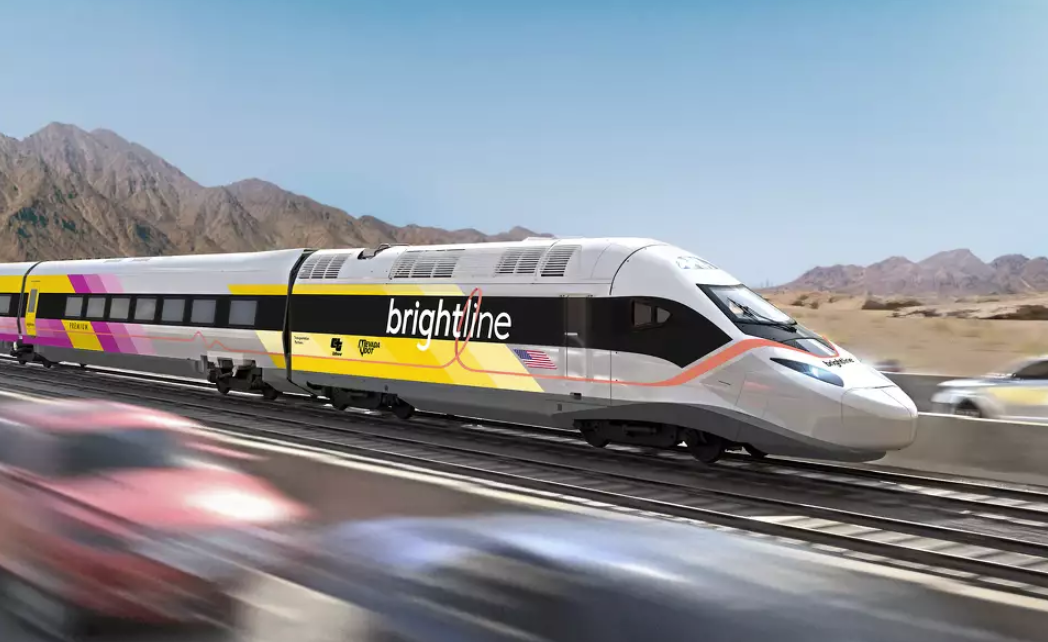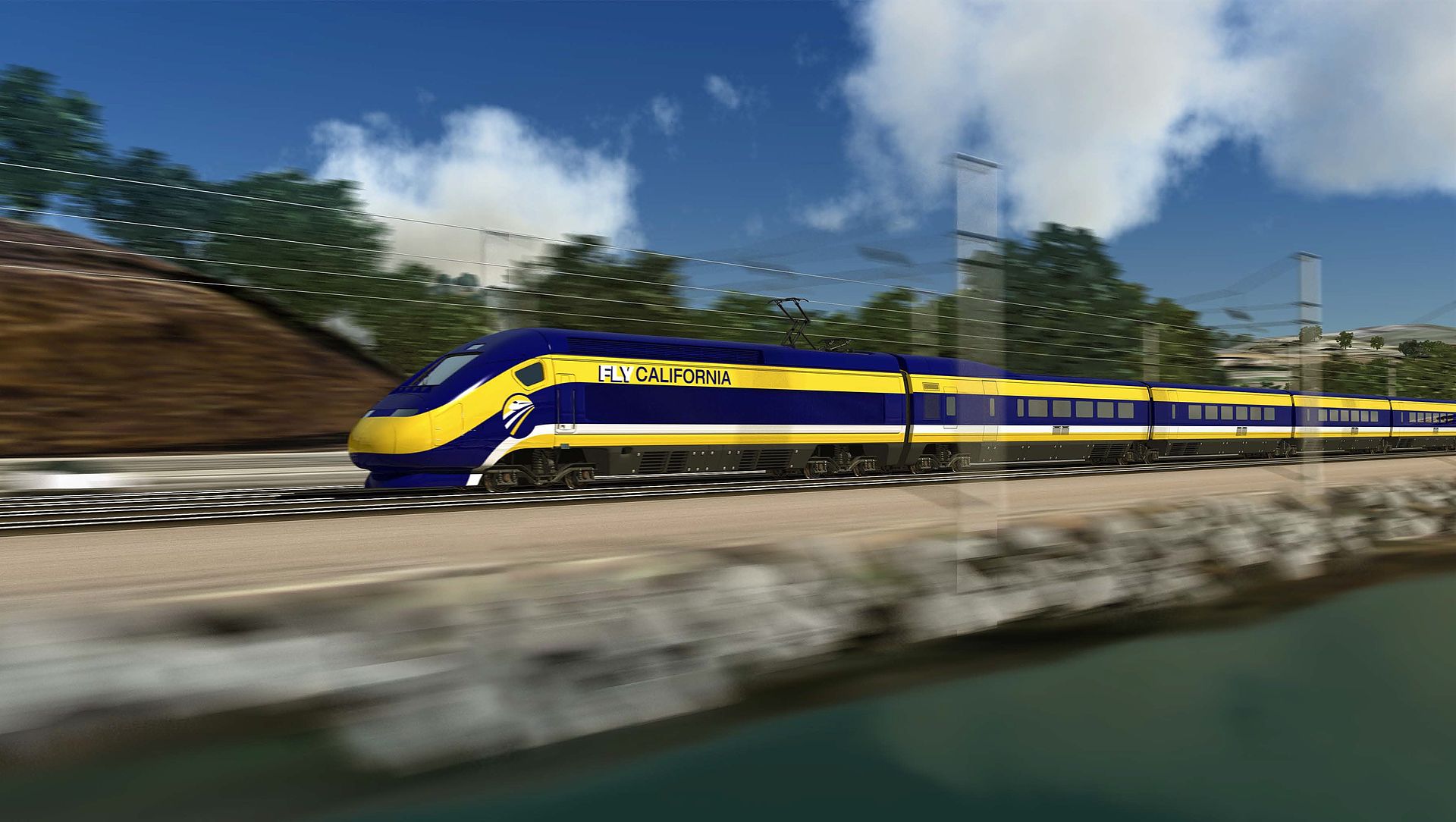
Brightline West Train (Photo: Brightline)
Biden Administration Awards $3 Billion to Brightline West Las Vegas-So Cal High Speed Rail Project
Cost of line has jumped from $8 billion to $12 billion in only the past few years
By Evan Symon, December 6, 2023 2:45 am
The Biden Administration announced on Tuesday that they would be awarding $3 billion through the Department of Transportation as part of the Infrastructure Investment and Jobs Act to help start construction of the Brightline West project, a high-speed rail project that is expected to connect Las Vegas with several cities in the Inland Empire.
Since the late 2010’s, the Florida-based Brightline has been planning a Las Vegas to Southern California high-speed route, with many issues, such as where the California end terminus should go, managing to be resolved. However, final hurdles, such as financing issues and construction delays, plagued the company in the last few years. In 2020, the state of California approved $600 million worth of bond allocations, paving the way for Brightline West, then paired with Virgin Trains USA, to build soon. However, according to Brightline, “election uncertainty, the lack of approval of a Covid-19 vaccine, and lack of liquidity in the market did not allow [Brightline West] to price the bonds to provide long-term stability for the company.”
As a result, state treasurer Fiona Ma took back the allocation bonds in November 2020 and Virgin dropped out of the project, stopping the project indefinitely. However, the company bounced back the next year, even planning groundbreaking ceremonies and getting final okays from the Californian Government.
The final plan, of having stations in Rancho Cucamonga, Hesperia, Victor Valley, and Las Vegas and a track that would largely be placed in the median of I-15. Future stations would include a linkup with Los Angeles proper, as well as routes to Phoenix, Salt Lake City and Denver.
In February, union agreements were finalized, and a construction start date was soon announced for later in the year. However, two major hurdles still remained: Final regulatory approval of the route, which is expected to largely be built in the I-15 median, and final federal funding, with California and Nevada lawmakers petitioning the federal government for $3.75 billion of the estimated $12 billion needed to complete it in time for the planned 2027 opening.
Last month, the Surface Transit Board (STB) approved the modified new line, now stretching 186 miles from Rancho Cucamonga to Las Vegas. This led to the Department of Transportation awarding a grant of $3 billion to the Brightline West project, with many being won over by economic benefits to both states, traffic relief along I-15, a cut in car emissions, and providing a cheaper option of travel between the two regions.
“This historic high-speed rail project will be a game changer for Nevada’s tourism economy and transportation,” said Senator Jacky Rosen (D-NV) in a statement on Tuesday. “It’ll bring more visitors to our state, reduce traffic on the I-15, create thousands of good paying jobs, and decrease carbon emissions, all while relying on local union labor.”
For decades, NV has heard about the benefits of high-speed rail.
Today, after months of pushing, I’ve secured critical funding to make this a REALITY.@BrightlineWest will:
⬆️increase NV tourism
⬇️reduce I-15 traffic
🤝create good-paying jobs
🔋decrease carbon emissions— Senator Jacky Rosen (@SenJackyRosen) December 5, 2023
Opposition against Brightline West
However, the Brightline West project has been opposed by many transportation experts, as well as many Californian and Nevadan locals who have said that the project will ultimately do more economic harm than good and that other options, such as a mass installation of charging stations along I-15, would prove to be more successful.
“This is as big a mistake as the California High-speed rail system,” said German passenger railroad consultant Horst Bauer to the Globe on Tuesday. “To have a successful high-speed line you need several cities to support the system along the way, even if connecting two large Metro areas. Besides a few two city lines in Germany, all high-speed rail here connects more cities. The same goes for Japan, the UK, and even the other Brightline project in Florida.
“Also, not too long ago, Brightline West had a price tag of $8 billion. As any Californian knows, an initial rail line price means nothing, and today it is at $12 billion. Who knows where it will be at mid-construction.”
In a previous interview with the Globe, Bauer also noted how many cities in between Las Vegas and Rancho Cucamonga would be ignored, including the heavily travel dependent cities of Barstow, Baker, and Primm.
“But Brightline has had a very bad reputation,” said Bauer in March. “Unlike Europe where they try to integrate cities with rail service to help businesses, they have not. In Florida, they have severely hurt local businesses and severely struggled financially for years. It is doing better now, but they also have the benefit of several nearby cities on the lines providing a better passenger stream, and like I said, severely hurts the ignored cities.
“The Inland Empire-Las Vegas route has even more issues. First of all, they need to stop calling it the ‘LA to Las Vegas route’ because it doesn’t even come close to Los Angeles. Second, the rails placement in the middle of a major highway. That should not have happened. It makes sense for lower speed rail to do that. But one wrong jump from the track or derailment and you could see highways blocked. It’s not exactly the most likely scenario, but it’s not zero either. Third, this rail system is going to kill off a lot of town dependent on car traffic. If they had stops there, they would help, but they don’t, instead relying on speed. And that would make sense going between two larger cities, but remember, this train is not between two large cities, it’s the Inland Empire and a station in Las Vegas but away from everything major.”
Bauer then added that Brightline would likely not hit passenger goals beyond the initial month.
“In the first month, there will be a lot of ridership. You know, it’s the new thing. But it will quickly shore up all those flaws, especially how people would then need to either physically park and drive from both locations or take public transit, which will only worsen parking areas along side those routes. Congestion along I-15 will go down, but it is going to be hell at a local level because of a lack of local services.
“This whole system is still car dependent, and any time saved by taking the rail will be spent with parking issues, mass transit waits, and a whole host of other delays and congestion factors at the local level. They should have hooked up directly to Los Angeles and invested more heavily in parking garages and added stations along the way for this to be anywhere close to being viable.
“High-speed rail is needed in the U.S., but this is a way not to do it.”
Brightline West is expected to open up service in 2027 in time for the Olympics.
- San Diego Country Supervisor Jim Desmond Calls San Diego New Epicenter Of Illegal Crossings By Migrants - April 27, 2024
- Oracle Moving Headquarters Out Of Austin Only 4 Years After Moving Out Of California - April 26, 2024
- Congressman Adam Schiff Robbed of his Luggage in San Francisco Car Break In - April 26, 2024




The only people who will benefit from this will be the contractors and the politicians, who will be getting kickbacks and generous donations to their re-election coffers. Be curious what kind of “reward” Wacky Jacky Rosen will get.
Not going to happen. It os like the other one that did not happen.
This is another high speed train that will never get built? As DB Holly mentioned in the post above, no doubt most of the funding will end up being disappearing with kickbacks and payoffs to consultants and politicians connected with the Democrat party like Nevada Democrat Senator Jacky Rosen?
This is a good project. Brightline West owns 110 acres near the Las Vegas Strip, which it will sell off for profit once the train goes through. They are making money on their Florida Miami-Orlando line, and this will eventually go into Los Angeles via the High Desert Corridor, which is partially funded. Metrolink’s SCORE program will improve the San Bernardino line for connections. The reality is passenger rail is the only way to ease traffic and eminent domain for new freeways has become politically unacceptable. California spends over 30 Billion a year on road and freeway maintenance, so I don’t understand why this is such a punching bag. Also, some people just like taking the train.